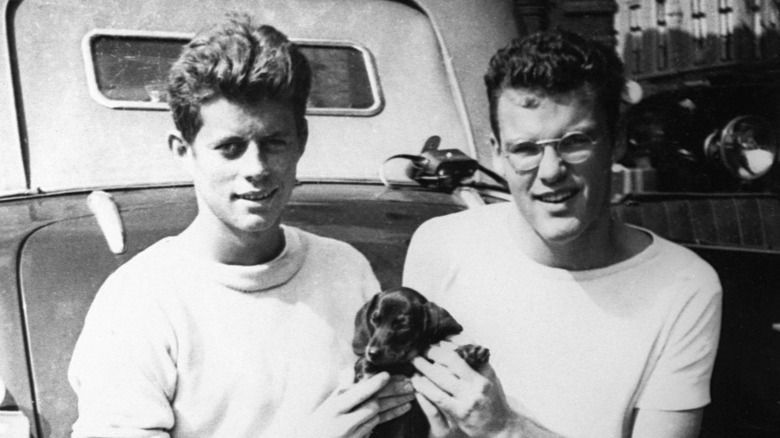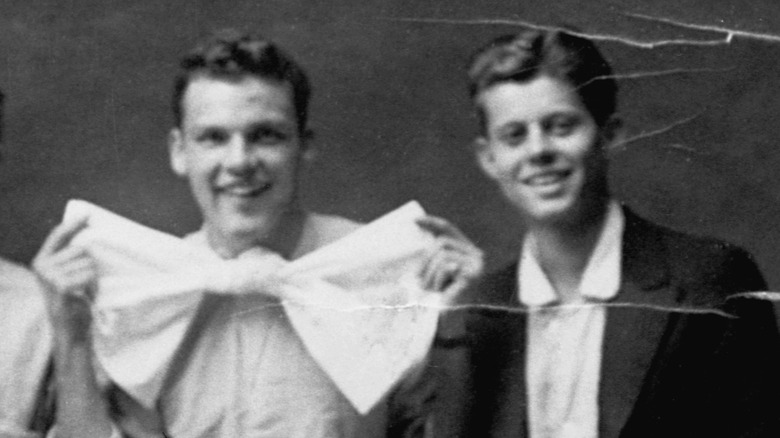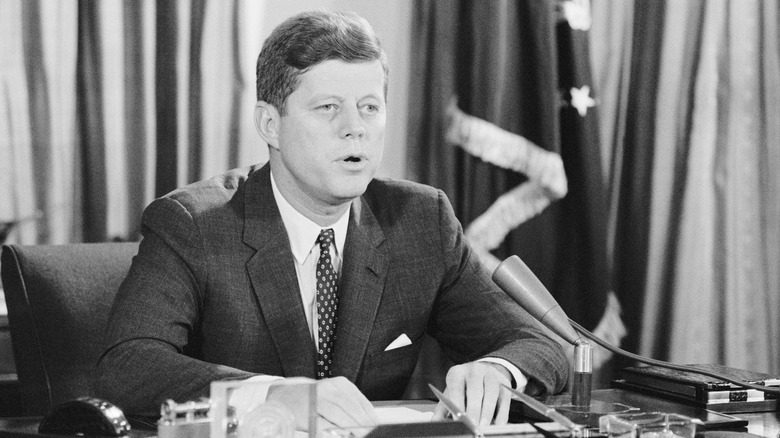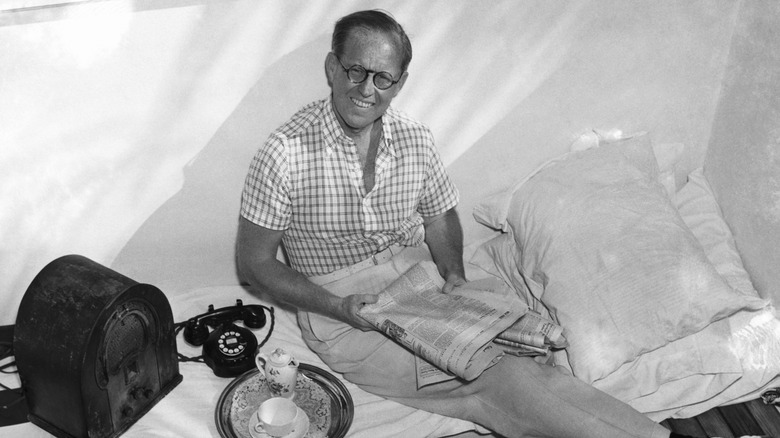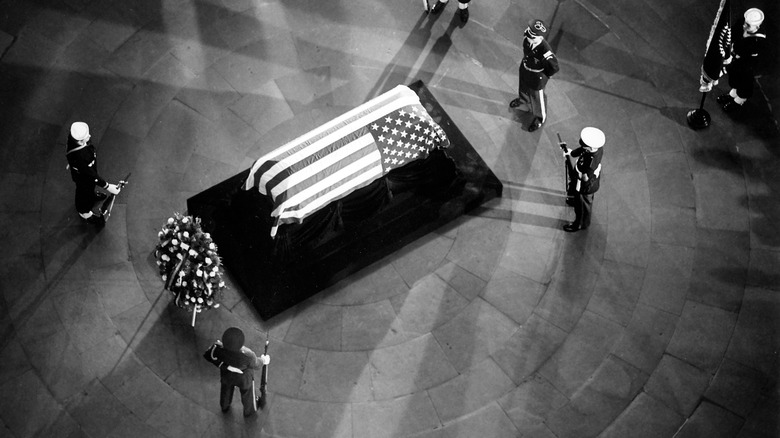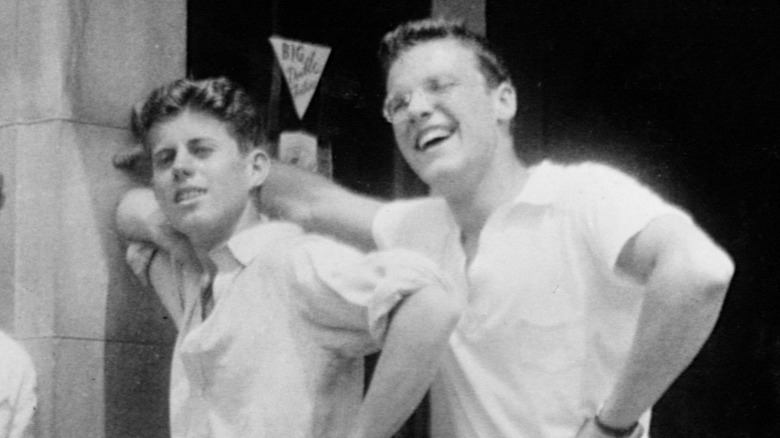The Man Who Was JFK's Best Friend
The best-known people in John F. Kennedy's life were members of his family — the formidable Kennedy dynasty under ambitious Senator Joseph P. Kennedy Sr. — and the women he became romantically entangled with in the public eye. John's elder brother, Joseph Jr., was a war hero, while his younger brothers Robert and Edward also followed in their father's footsteps and entered politics. Several of JFK's sisters became prominent public figures, while his wife, Jacqueline, was an icon in her own right. JFK is also closely associated with the timeless actress Marilyn Monroe thanks to allegations that the pair had an affair during his presidency.
But there was another figure in JFK's life who remained a constant throughout his highs and lows: Kirk LeMoyne Billings, better known as "Lem." Through scholarship, Billings managed to attend Choate Preparatory School, where JFK was also in attendance. The two became lifelong friends even after JFK entered the White House. In fact, at the moment when he might have dropped his old friend, JFK brought Billings closer to him and his family. As noted by the John F. Kennedy Library, Billings is one of the few figures not related to the Kennedy family by blood or marriage who features in both JFK's family photos and those taken in an official capacity at the White House. Though it ended in tragic circumstances with JFK's assassination in Dallas, Texas, on November 22, 1963, the story of their friendship is one of the most heartwarming aspects of Kennedy's presidency.
The Muckers
John F. Kennedy met Lem Billings, who was one year his senior, while working on a yearbook at Choate Preparatory School. The two teens established an instantaneous rapport and reveled in their shared mischievous sense of humor.
Choate was known as an institution keen on order and tradition. According to the John F. Kennedy Library, he and Billings made a point of pushing the boundaries when it came to breaking rules that they thought were unreasonable and unnecessarily restrictive, such as playing records in the evenings when music was officially meant to be turned off. The pair even established their own club, "The Muckers." The name was taken from the principal's term for troublemakers, and it became a badge of honor among such young men as JFK and Billings.
In 1937, at the start of their 20s, the pair cemented their friendship with a two-and-a-half-month trip around Europe, where they visited such attractions as the Leaning Tower of Pisa, taking silly photographs along the way. Both men became involved in World War II, with JFK entering the U.S. Navy and serving in the South Pacific and Billings signing up as an ambulance driver in North Africa, but the friends stayed in touch throughout the war via mail and were sure to meet up whenever possible.
A constant but marginal White House presence
When World War II ended, John F. Kennedy came home a hero thanks to his involvement in saving the lives of his shipwrecked crew. He also became a minor literary celebrity thanks to the publication of his first book in 1940, an analysis of the opening phase of the war titled "Why England Slept." However, before the 1940s were out he was already making his first steps in politics, being elected to the House of Representatives. In 1953, he was elected to the Senate.
Lem Billings remained JFK's close friend and confidante during his political ascendancy. Though he had a career of his own in the private sector during certain portions of his life, he regularly assisted JFK, and later, his brother Robert, on the campaign trail. When JFK won the presidency, Billings remained close. Unlike several of the president's other friends and allies, Billings never took an official role in JFK's administration, as the politician reportedly didn't want it to get in the way of their friendship. However, Billings did have a room at the White House. In fact, JFK's aide Dave Powers said Billings was such a constant presence that he was occasionally mistaken for a member of the Secret Service. Instead, he helped the president to relax, and according to David Pitts' "Jack and Lem" often played host at dinner parties when Jacqueline Kennedy was otherwise engaged. Pitts describes Lem's role as that of "First Friend" to the president.
The fourth Kennedy brother
Future president John F. Kennedy wasn't the only member of the family close with Lem Billings. In fact, he was deeply involved with the clan as a whole. Joseph P. Kennedy Sr. (pictured) even singled him out for praise, describing Billings as his "second son" in a letter of recommendation he wrote for him during World War II (per "Jack & Lem"). The phrase seems unusual considering that Joseph Sr. in fact had four sons, but it can be explained by the fact that Billings was only behind Joe Jr. in age among the Kennedy brothers.
Indeed, Billings was widely popular among the Kennedy family as a whole, often acting as an escort for JFK's sisters. He was so close to JFK's sister Eunice that he was once presented to her as a surprise Christmas present, according to "Jack & Lem." He was even entrusted with the task of transporting pet hamsters — a gift for JFK's daughters — from New York to the White House, as reported in The New York Times.
The death of John F. Kennedy
The assassination of John F. Kennedy in 1963 put an end to what has been widely described as the central relationship in Lem Billings' life. He last saw his best friend at a White House dinner held in honor of the actress Greta Garbo. JFK's death was a great shock, and Billings experienced depression as a result. In "Jack & Lem," David Pitts claims that JFK's death affected Billings deeply, and in his later life he developed a drug habit alongside JFK's younger brother Robert, with whom he grew closer after his longtime friend's death.
In a much-quoted passage from her book "Grace & Power: The Private World of the Kennedy White House," Sally Bedell Smith describes Lem Billings as "probably the saddest of the Kennedy 'widows.'" Nevertheless, he stayed close to the Kennedy family. Billings died of a heart attack in 1981 at the age of 65. Several members of the Kennedy family acted as pallbearers at his funeral.
A love affair?
One aspect of Lem Billings' life that has become of greater interest to the wider world than it did during his friendship with John F. Kennedy is his sexuality. It later became public knowledge that Billings was gay, a fact that was reportedly known to Kennedy's inner circle and the friends the two men had in common. Despite the era in which they lived being notably more sexually repressed than society is today, it has been reported that Billings' sexuality was accepted by his social circle and those in the know around Kennedy. However, considering the regressive views of wider society at the time — and presumably Kennedy's conservative opponents — it was never made public or talked about in the open.
This fact raises questions about the nature of Billings and Kennedy's relationship, which has drawn the interest of modern historians. Billings' admiration for his lifelong friend who rose to the top of American politics before being tragically gunned down is now public record. But could he have been in love with Kennedy, and if so, did Kennedy know about it? David Pitts, who does use the word "love" to describe Billings' feelings toward JFK, has claimed that Billings made sexual advances toward Kennedy as early as 1933. Kennedy allegedly wasn't interested but was happy to maintain their close relationship regardless (per "Jack & Lem"). Other more sensationalist historians such as "The Kennedys in Hollywood" author Lawrence J. Quirk have claimed that their relationship was indeed sexual even when JFK was in office, information Quirk claims he received from Billings himself. However, this has never been substantiated.
